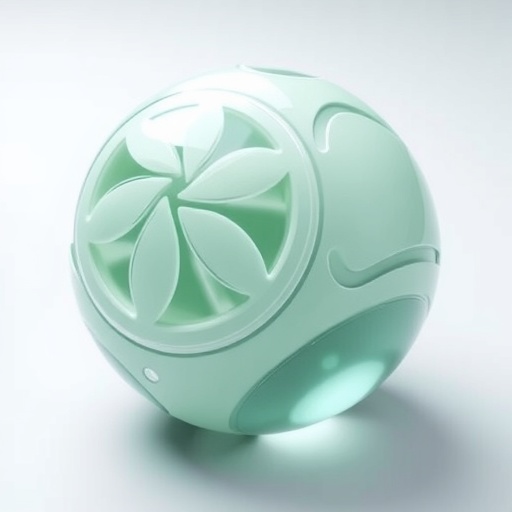Researchers at the Technical University of Munich (TUM) have made groundbreaking strides in biomedicine with the development of hollow microspheres composed of mucus and polydopamine. This innovative creation is not merely a scientific novelty but a potential game-changer in the field of drug delivery systems. The researchers designed these microspheres to serve as versatile carriers for therapeutic substances, specifically targeting difficult-body locations such as joints or the oral mucosa where traditional drug delivery methods struggle to adhere. By leveraging biopolymers and state-of-the-art material science, they have opened the door to a new realm of medical applications.
Professor Oliver Lieleg, who leads the research team, emphasizes the critical role of mucins—natural glycoproteins found prominently in the linings of our body, including our stomach and mouth. The interaction of mucins with various materials paves the way for innovative solutions in biomedicine. This team’s latest creation is not just a hollow sphere; it is a multifunctional drug delivery system that ensures a controlled release of therapeutic agents at specific sites within the body, thus enhancing treatment efficacy where it is most needed.
One of the standout features of these hollow microspheres is their markedly good adhesion to biological tissues. This was made possible by the strong adhesive properties inherent to polydopamine, a polymer derived from dopamine and known for its remarkable surface adhesion characteristics. The added advantage of mucin contributes to the microspheres’ functionality, providing crucial attributes such as tunable pore sizes and acting as a natural lubricant. This is particularly beneficial in joint applications where excessive friction could lead to tissue damage during movement, thereby improving joint health and providing a layer of protection for sensitive areas like the oral mucosa.
The production process of these microspheres is both straightforward and scalable, which is vital for potential commercialization. The method initiates with coating a solid core with mucus and polydopamine, after which the core is meticulously removed to yield a stable hollow structure. Unlike other materials that radically shrink or collapse upon core dissolution, these microspheres maintain structural integrity thanks to their unique composition. This durability enables the addition of therapeutic cargo post-production through diffusion, as tested with model cargo molecules in preliminary studies.
To further enhance the utility of these microspheres, the TUM research team incorporated an additional component that partially seals the microspheres after they are loaded with therapeutic substances. This sealing step serves a dual purpose: it significantly retains more of the loaded cargo within the hollow structures while also allowing for a gradual, controlled release. Among various materials tested, the use of silver ions proved to be particularly effective in this sealing process, showcasing the flexibility of the microsphere platform.
However, the choice of sealing material has profound implications for the effectiveness of the drug delivery system. When silver ions are incorporated, the microspheres exhibit cytotoxic effects that can be harnessed for targeting tumor cells, providing a strategic avenue for cancer treatment. Di Fan, the first author of the research, highlights the importance of understanding these biological interactions, showcasing the microspheres’ ability to either protect cells against chemical stress or eliminate them based on the specific requirements of the treatment strategy.
Without the inclusion of silver ions, the properties of polydopamine come to the forefront, manifesting as anti-inflammatory effects that could significantly aid in conditions like osteoarthritis or chronic wounds characterized by persistent inflammation. The ability of these microspheres to modulate their effect depending on the surrounding biological environment creates an adaptable platform for a variety of therapeutic applications that can meet the complex demands of modern medicine.
Additionally, this dual functionality of the microspheres—either protecting or killing cells—underscores a pivotal advancement in drug delivery technology. The research team from TUM has created a platform that could very well redefine therapeutic strategies in regenerative medicine. Not only do these microspheres represent a novel means of delivering medication, but they additionally embody the principles of smart materials that react intelligently to their biological milieu.
The advent of these multifunctional polydopamine-mucin hollow microspheres marks a significant leap toward personalized medicine, where treatments can be tailored to the individual needs of patients based on their specific ailments and biological responses. Researchers envision a future where these smart carriers optimize therapeutic outcomes while minimizing side effects, thus transforming the landscape of drug delivery systems.
Furthermore, the prospect of scalability makes these microspheres an attractive option for widespread clinical applications. The ease with which these microspheres can be produced and modified suggests that they can be incorporated into various therapeutic settings, from local treatments in targeted areas to broader systemic applications. By advancing towards practical applications, the research team seeks to bridge the gap between laboratory innovation and real-world medical solutions that can be systematically integrated into healthcare delivery systems.
In summary, the development of polydopamine-mucin hollow microspheres signifies a promising convergence of material science and biomedical engineering. As the researchers set their sights on future studies and applications, it is clear that their work not only contributes to the scientific community but also holds the potential to enact meaningful change in patient care and outcomes. With their unique capabilities, these microspheres could soon become integral players in combating a range of medical issues, paving the way for a future where material innovations directly enhance human health.
Subject of Research: Cells
Article Title: Multi-Functional Polydopamine-Mucin Hollow Particles Provide Tunable Shell Permeability, ROS Scavenging, Tissue Adhesion, and Lubricity for Biomedical Applications
News Publication Date: 4-Jul-2025
Web References: 10.1002/smll.202503238
References: Not available
Image Credits: Not available
Keywords: drug delivery, microspheres, biomedicine, polydopamine, mucin, therapeutic substances, cancer treatment, inflammation, tissue adhesion, scalable production, personalized medicine
Tags: advanced material science in healthcarebiomedicine breakthroughscontrolled release of therapeutic agentshollow microspheres for drug deliveryinnovative drug delivery systemsmucins and drug adhesionmucus-based biopolymers in medicinemultifunctional spheres in biomedicinepolydopamine in medical applicationstargeted drug delivery to jointsTechnical University of Munich researchtherapeutic substance carriers





